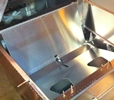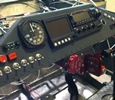


random user submitted photo
Cylinder heads temp leads
17 posts
• Page 2 of 2 • 1, 2
Re: Cylinder heads temp leads
Later model Jab engines had a small hole drilled between the spark plugs that was ideal for anchoring a small eyelet holding the thermocouple and gave about same readings as the under-the-plug location. A small short eyelet places the actual thermocouple (the junction of the two wires) closer to the head and thus somewhat less influenced by cooling air. With either, slipping a bit of thermal insulation over the thermocouple leads and the eyelet greatly reduces the heat lost to cooling air on the wires which otherwise conducts heat away from the junction and results in readings that are closer to actual head temperature, about 15-20 degrees higher than standard exposed under-the-plug setup results in. Per Ian Bent of CAMit, the original builder of Jabiru engines before CAMit went belly up, the maximum temperatures Jabiru lists are a bit too high and will result in loss of temper in the grade of aluminum used resulting in the top rim of the cylinders sinking into the aluminum heads.
Some folks have installed the thermocouples down into the small hole, this gives considerably higher readings, but does not reference to what others are referencing so you are on your own doing that. If doing so, the thermocouple junction must be bedded into the hole with some thermal conductive material, not just stuck down the hole or the wires will conduct away more heat than the poor contact with the heads will warm the junctions.
Davd A.
Some folks have installed the thermocouples down into the small hole, this gives considerably higher readings, but does not reference to what others are referencing so you are on your own doing that. If doing so, the thermocouple junction must be bedded into the hole with some thermal conductive material, not just stuck down the hole or the wires will conduct away more heat than the poor contact with the heads will warm the junctions.
Davd A.
- DCASonex
- Posts: 904
- Joined: Mon Sep 12, 2011 8:04 pm
- Location: Western NY USA
Re: Cylinder heads temp leads
Kai wrote:For one I am a little confused here! As far as I seem to recall from my Jab gen 1 and -2 days, the Jab installation manual indicates the cht sensor ring is supposed to go under the sparkplug closest to the exhaust valve (not the inlet valve).
Discussions have run high for the best position for the pickup. Under the plug is fine, but there is a lot of cooling air circulating there actually causing erroneous readings. The hottest position of the head is on the underside of it, close to the lower cyl head bolt. There have been suggested numerous solutions to pick up the cht at this position.
Thx
Hi thanks for the reply. So, if this is the case are most people now placing them under one of the head bolts and if so which one closest to the exhaust is the best?
Mark
Lyncrest Airport - CJL5
Winnipeg, Manitoba
Sonex Legacy #0327
Jabiru 2200
Serial # 22A 1130
AeroConversions
Winnipeg, Manitoba
Sonex Legacy #0327
Jabiru 2200
Serial # 22A 1130
AeroConversions
- Wood
- Posts: 56
- Joined: Sat Aug 14, 2021 9:38 am
- Location: Winnipeg
Re: Cylinder heads temp leads
Hi Mark, the head bolt at six o'clock is usually the one that needs torquing because of high chts, so I guess that would be
the best choice for a sensor. You could do a test with an 'under the plug' sensor and one on the head bolt to compare readings, so you
have a reference. Then go with just the head bolt ones.
Or maybe use a laser temperature gun to scan the heads when they are up to temp? Maybe there is a better location for the sensors.
Rick
the best choice for a sensor. You could do a test with an 'under the plug' sensor and one on the head bolt to compare readings, so you
have a reference. Then go with just the head bolt ones.
Or maybe use a laser temperature gun to scan the heads when they are up to temp? Maybe there is a better location for the sensors.
Rick
- Rick524
- Posts: 159
- Joined: Fri Jun 03, 2011 11:40 am
Re: Cylinder heads temp leads
Rick524 wrote:Hi Mark, the head bolt at six o'clock is usually the one that needs torquing because of high chts, so I guess that would be
the best choice for a sensor. You could do a test with an 'under the plug' sensor and one on the head bolt to compare readings, so you
have a reference. Then go with just the head bolt ones.
Or maybe use a laser temperature gun to scan the heads when they are up to temp? Maybe there is a better location for the sensors.
Rick
Ugh - getting a CHT sensor under the #6 head bolt would be a bloody nightmare. Not much room to work under there. Plus, you can't actually remove that bolt and huge load spreading spacer it goes through with the head still on the cylinder. You would have to loosen bolt all the way and try to pull it back, pull the large spacer back, and try and slip the ring terminal it under the spacer and the head and have a long enough ring terminal so you aren't pinching the wires when tightening it down. You can't even remove that bolt/spacer when the head is on the cylinder as the pushrod tubes are in the way. I know, am just putting a head back on right now and forgot to put the spacer/bolt in first before sliding the head on - had to remove head again to do this. I would totally punt on the concept of #6 unless you have the head off already.
Lorin
Waiex N81YX, Jab3300
- ldmill
- Posts: 90
- Joined: Mon Nov 21, 2011 2:30 am
Re: Cylinder heads temp leads
I originally bought CHT sensors for fitting under the spark plugs on my Gen 1 engine but there wasn't enough space to fit them. I suppose I could have removed a large piece of cooling fin but that didn't seem like a great idea so I made some little "top hat" bushes and fitted them under head bolts. Eventually I made a mod to the heads by machining a small amount from some fins that enabled fitment of much more compact thermocouples to a small fin between the spark plugs. The readings from the new thermocouples were about 10 - 15°C higher than from under the head bolts.
Peter
Peter
- peter anson
- Posts: 546
- Joined: Thu Jul 31, 2014 2:34 am
- Location: Mount Macedon, Australia
Re: Cylinder heads temp leads
It’s a good point that you can measure the cht’s till you are blue in the face, but you need some kind of reference. The one Jab provides is under the exhaust plug (and never mind the cooling air!)
Bear in mind, that the ring provided with the cht senders is just for attachment. The leads are the actual temp pickup senders. The ring (often stainless!) could just as well be replaced with one having a different dimension. Thus I have also seen cht leads attached to under the heads of the lower capscrews on the exhaust pipe flanges.
Another point is that the Jab limits are on the high side for safe operation. In long discussions with Ian Brent of Camit, now VERY sadly inaccessible for comments because he was an absolute ocean of willingly shared information, we settled on a never to be exceeded cht limit of 140 degs C, and a cruise limit of 120 centigrades. Comparing this value to other makes, is fairly low. The reason is that because of the cnc billet production process, aluminium stock had to be used that would loose its temper at lower limits than normally expected.
It took some head scratching to achieve this lower limit on operational engines- not before the original Jab cooling ducts were replaced with a tight fitting cooling plenum à la AeroVee were we satisfied. Mind you, that was years after the tribulations with my Sonex. There I finally threw in the towel and went with liquid cooled heads, and a split radiator installation. Life became less complicated after that!
Of course, all of the above is for the gen 1, -2, and -3 series. The new gen 4 is totally different.
Thx
Bear in mind, that the ring provided with the cht senders is just for attachment. The leads are the actual temp pickup senders. The ring (often stainless!) could just as well be replaced with one having a different dimension. Thus I have also seen cht leads attached to under the heads of the lower capscrews on the exhaust pipe flanges.
Another point is that the Jab limits are on the high side for safe operation. In long discussions with Ian Brent of Camit, now VERY sadly inaccessible for comments because he was an absolute ocean of willingly shared information, we settled on a never to be exceeded cht limit of 140 degs C, and a cruise limit of 120 centigrades. Comparing this value to other makes, is fairly low. The reason is that because of the cnc billet production process, aluminium stock had to be used that would loose its temper at lower limits than normally expected.
It took some head scratching to achieve this lower limit on operational engines- not before the original Jab cooling ducts were replaced with a tight fitting cooling plenum à la AeroVee were we satisfied. Mind you, that was years after the tribulations with my Sonex. There I finally threw in the towel and went with liquid cooled heads, and a split radiator installation. Life became less complicated after that!
Of course, all of the above is for the gen 1, -2, and -3 series. The new gen 4 is totally different.
Thx
- Kai
- Posts: 238
- Joined: Wed Jul 30, 2014 1:36 am
Re: Cylinder heads temp leads
Hi guys. Sorry about the late reply. You’re all providing a wealth of knowledge so thanks for that. I ended up shaving a little of the fin around the plugs to be able to fit the CHT ring, which seems to fit nicely now. I’ll most likely try the head bolt area later this year. Once I change the cooling baffles and compare the temp difference.
Cheers
Mark
Cheers
Mark
Lyncrest Airport - CJL5
Winnipeg, Manitoba
Sonex Legacy #0327
Jabiru 2200
Serial # 22A 1130
AeroConversions
Winnipeg, Manitoba
Sonex Legacy #0327
Jabiru 2200
Serial # 22A 1130
AeroConversions
- Wood
- Posts: 56
- Joined: Sat Aug 14, 2021 9:38 am
- Location: Winnipeg
17 posts
• Page 2 of 2 • 1, 2
Who is online
Users browsing this forum: No registered users and 4 guests







